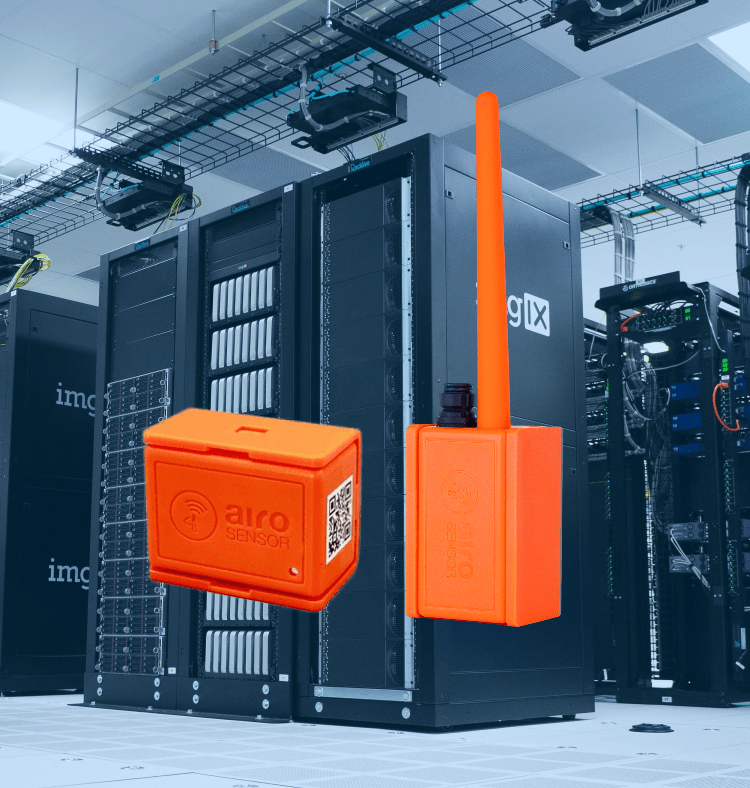Monitor environmental conditions in the data center
Monitoring the temperature and humidity parameters is a key factor in preventing harmful heat build-up or humidity and at the same time operating data centers in an energy-efficient manner.
Energy consumption and heat generation in modern data centers are constantly increasing, while servers are becoming smaller and smaller and power density is increasing. In some cases, modern servers generate up to 10 times more heat than was planned when dimensioning the air conditioning system.
If the heat in the server rooms is not dissipated quickly enough, the risk of hardware damage and data loss increases. To avoid downtime, data centers are often undercooled, which results in unnecessary energy consumption. Air conditioning must be planned accordingly and the temperature in the data center must be monitored. Monitoring energy consumption in server rooms is also essential. Two approaches are used to evaluate the efficiency of the energy used in data centers: PUE (Power Usage Effectiveness) and DCIE (Data Center Infrastructure Efficiency). Too high or too low humidity can also lead to undesirable consequences.
Climate parameters at a glance - 24/7 365 days a year
React before damage occurs: If something is wrong in your server environment, SenseAnywhere alerts you by e-mail, SMS, phone call or a third-party system.
Maintaining a complex server environment can be a major challenge. Ensure the correct functioning of your environment with automated climate monitoring.
Receive real-time alerts for events in the server room that require your attention. SenseAnywhere data loggers for data center temperature monitoring can alert you to abnormal rack or HVAC duct temperatures. Our product line can also monitor many other variables related to symptoms and conditions, such as increased power consumption or the presence of moisture. With the SenseAnywhere monitoring system for remote monitoring of data centers and server rooms, you can always be sure that the systems in your server environment are functioning optimally.
- Wireless monitoring system with API interface
- Out-of-the-box temperature and humidity measurement
- Secure, redundant storage of your measurement data
- Real-time alerting
- Location-independent access
- Ecologically sustainable solution
- Free demo kit

Temperature in the data center
Even a small change in temperature can have a significant impact on operating costs.
Temperature monitoring helps you to assess the efficiency of your cooling system. To monitor the temperature, sensors should be installed at critical points. The top, middle and bottom of the racks as well as the air inlets and outlets should be monitored. Placing sensors at the front and rear of the racks and at the inlet and outlet of the CRAC and air conditioning units allows the ∆T (temperature difference) between 4 key points to be analyzed.
Humidity in the data center
In a data center, humidity that is too high or too low can pose a risk to the devices.
Monitoring the humidity in data centers contributes to the proper operation of your devices. If humidity levels are not controlled, this can lead to unforeseen downtime and therefore significant costs. If levels are too low, equipment can become electrostatically charged and cause deadly static electricity. Condensation should be avoided to prevent corrosion and electrical short circuits.
Recommended climate values for server rooms and data centers
The American Society of Heating, Refrigeration and Air-Conditioning Engineers (ASHRAE) recommends the following in its guidelines for the operation of data centers:
- A temperature of 18 °C to 27 °C
- A humidity of 40 % to 60 % rH
Test our temperature monitoring system free of charge!
Test the demo kit free of charge and without obligation within one week. Take your time and test the advantages and possibilities that SenseAnywhere offers you. Directly on your premises, with your conditions and your data. Measure the temperatures in your pharmacy, trigger alarms, create documentation and familiarize yourself with the system.
The demo kit contains two data loggers, an access point and everything you need to commission the system on site and record your own temperature and humidity data.

With our climate monitoring solution, the temperature and humidity in your environment can be documented electronically without errors.
Whether manually reading out a data logger or fully automatically transferring the recorded measurement data to the cloud. The measured values can be viewed at any time and historical data can be easily accessed.

Are you subject to a duty of proof? For documentation purposes or as proof, you can create and save a report with all relevant data at any time or have a report sent to you fully automatically by email.








